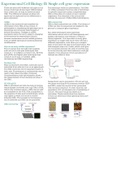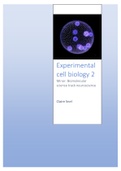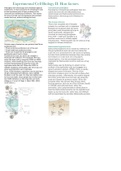Vrije Universiteit Amsterdam (VU) • Minor Biomolecular sciences and neuroscience
Meest recente samenvattingen voor de opleiding Minor Biomolecular sciences and neuroscience op de Vrije Universiteit Amsterdam (VU). Op zoek naar een samenvatting voor Minor Biomolecular sciences and neuroscience? Wij hebben diverse samenvattingen voor de opleiding Minor Biomolecular sciences and neuroscience op de Vrije Universiteit Amsterdam (VU).
-
32
-
11
-
3
Vakken Minor Biomolecular sciences and neuroscience op de Vrije Universiteit Amsterdam (VU)
Er zijn samenvattingen beschikbaar voor de volgende vakken van Minor Biomolecular sciences and neuroscience op Vrije Universiteit Amsterdam (VU)
Nieuwste samenvattingen Vrije Universiteit Amsterdam (VU) • Minor Biomolecular sciences and neuroscience
This document provides a summary of the whole Experimental Cell Biology 2 course. **You can also find the separate lectures on my profile! Topics that are discussed are: Endothelial cells (leukocyte extravasation, chemokines, and stem cell homing), Basic techniques in cell biology (PCR, chromatography, sequencing, knock-out, fluorescent probes, RNAi, and CRISPR/Cas9), Proteomics/ mass spectrometry (including Alzheimer’s, LCM, tangle formation and braak stages), Host factors (Salmonella, S...
This document provides a summary of proteomic techniques, such as mass spectrometry. The focus lies on tandem MS, peptide fragmentation, MS/MS, Maldi and electrospray, Time-of-flight, orbitrap and the pathology of Alzheimer’s disease and how the MS contributes to the research. There is also a brief summary of Braak stages, laser capture microscopy, tangle formation, and immunohistochemistry.
This document provides a summary of the lecture Single-cell gene expression. Topics that are discussed are: mRNA, mRNA expression, Northern blot, qPCR, RNA sequencing, DNA microarray, gene expression, single-cell gene expression analysis, High-throughput single-cell RNA analysis methods, Low throughput single-cell RNA analysis methods, FISH, smFISH, mRNA localization, Gene expression analysis in living cells and MS2/PP7 systems
This document contains lecture notes of the entire course. It contains images with descriptions of them when necessary.
This document contains an overview of the discovery and pathway of apoptosis. In this summary literature articles are used and linked.
This document provides a summary of the following subjects: intracellular pathogens, bacteria, human kinome, Salmonella thyphimurium, structure-activity relationship (SAR), molecular mechanisms of Salmonella, small GTPases, intracellular transport in Salmonella, Phosphoinositides, endosomes, AKT, Rab14, Rab9, AS160, Nischarin
This document provides a summary of the following subjects: Microbiome, microbiota, phylogeny, taxonomy, microbes, biofilms, gastrointestinal microbiota, gut microbiota, oral microbiota, Porphyromonas gingivalis, urogenital microbiota, skin microbiota, antibiotics, faecal bacteriotherapy, Koch’s postulates pathogens/probiotics, prebiotics, microbiome research
This document provides a summary about the basics of cell biology. It is a brief summary about the different cell compartments, such as the cell membrane, nucleus, nucleolus, ER, Golgi apparatus, mitochondria, lysosomes, transport vesicles, cytoskeleton, chloroplasts, the cytosol, ATP, Ion motive forces, Glycolysis, Pyruvate oxidation, Citric acid cycle, Oxidative phosphorylation, Respiratory chain/electron transport chain, ROS formation, ATP as a drug target, ATP in synapses, Warburg effect, P5...
This summary contains information about: RNA polymerase, Intragenic promoters, CpG island promoters, DNA cis-acting elements, histone modifications, epigenetics, enhancers, DNA methylation, and tumours.
This summary contains information about: DNA replication mechanisms, DNA polymerase III proofreading, strand-directed mismatch repair, post-replication DNA repair, base excision repair, mutations, nucleotide exchange repair, double-strand break repair, nonhomologous end joining, homologous recombination, RecA, Rad51, Rad52, molecular chaperones, HSP70, HSP60, proteasomes, ubiquitin, amyloid formation, heat-shock response, and HSF1.










